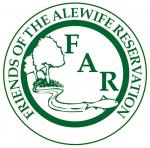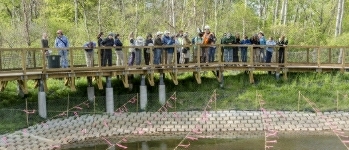by Mike Nakagawa from the Fresh Pond Residents Association blog
From Resident and Engineer, Mike Nakagawa:
I believe the combined sewer systems basically are the same in CAM004 CSO (Combined Sewer Overflow) as they had here in the former CAM400 CSO area. The point of the sewer separation was not directly to keep stormwater out of the sanitary sewers, although that was part of the project. The main driving force was that Cambridge was in violation of federal NPDES (National Pollutant Discharge Elimination System) regulations, in which untreated (raw) sewage from your toilets was being released directly into Alewife Brook.
The main problem was as follows:
- Cambridge has stormwater and sanitary sewer lines that are near each other, and particularly at personnel access points (manholes), where there were openings to both piping systems.
- Big storms caused too much water to flow into the stormwater sewers beyond their capacity.
- The extra water would leak into the sanitary sewers to be carried away to Deer Island for processing.
- Sending stormwater to Deer Island was not much of a problem, except for unnecessary cost, unless the storms reached the next level, in which those pipes reached their capacity.
- At that point, not all the farther away (un)sanitary sewage could flow down the pipes, so it just mingled with the stormwater.
- Although both exit routes were beyond capacity, some of the combined sewerage would flow into Alewife Brook, or into streets and yards, depending on how much extra water there was.
Another problem, the extra stormwater in the sanitary lines could cause basement drains to flow backward, unless fitted with a backflow preventer, dumping raw sewage into basements.
Too many storms per year were releasing millions of gallons of raw sewage into the Brook. So to comply with federal rules on cleaning up the discharges, before Cambridge started getting fines, the city came up with a plan. Part of the plan was to try to completely separate stormwater and sanitary sewers in the worst offending areas, so that raw sanitary sewage could not back up into the stormwater discharges into Alewife Brook.
Since all this effort was made to do the separation, they are also trying to keep stormwater from going into sanitary lines, which would reduce our payments for full water treatment, particularly since stormwater doesn't need to be highly treated. Also, limiting sanitary sewer usage to non-stormwater sources would decrease the probably of basement backups. Also, there would be more sewer capacity for new development. However, since a lot of old houses had roof drains that went into the sanitary lines, I think they are only getting as many of the easy cases as they can. Their main concern was the street drains.
However, now there's a whole lot more stormwater that needs to be handled, since it's not being sent to Deer Island. But you can't just send it into Alewife Brook because that would increase flooding in big storms, which is in violation of the Wetlands Protection Act. So they needed to make big underground culverts, I believe in the Quadrangle, to act as detention basins. They felt buying land for open ponds was too expensive.
Another problem was street contamination being dumped into the brook. So they struck a deal with the state to use part of the Alewife Reservation as a way to collect stormwater, which dumps untreated street run-off into the wildlife area. It seemed (to me) like a lot of concentration of contamination and road salt put into a small area, but they claimed it would work.
I think rainwater runoff from roofs is probably a lot less contaminated than the stuff left behind by cars on roads.
The catchbasins they were supposed to install (I haven't checked, but I assume they were the right ones) are "hooded catchbasins." The idea is that street runoff (including litter, leaves, and pet droppings) falls into tanks at the curb grates. The heavier stuff settles, and needs to be scooped out periodically. There is a relatively small area under a hood covering the drain opening on the upper part of the side wall of the tank. The hood extends below the drain opening, but is open at the bottom, so water above the drain level flows under the hood and out. Floating objects and chemicals stay at the top of the water level, and can't drain because of the hood. The water level doesn't go below the bottom of the hood because it stops emptying when the level gets to the bottom of the drain opening (on the side wall of the tank). http://water.epa.gov/scitech/wastetech/upload/2002_06_28_mtb_floatctrl.pdf
Since they are doing all this work, it is a good time for them to upgrade all the infrastructure: water supply and gas lines, at least they did that here. If you have galvanized pipe water lines, it would be a good time to change them if they are doing the water lines. Old galvanized pipe leaches out lead from the galvanization process, and eventually, after about 40-60 years, the zinc wears out and the pipes rust, causing reduced water pressure and breakage. The city takes care of the pipes from the branch in the street to the cutoff valve in the sidewalk. When all that is dug up, it's fairly inexpensive to do the replacement from the cutoff to your basement, but you need to get a qualified plumber to do it. Only some have the right certifications and insurance to connect to the city lines.
- Home
- Directions
- FAR Wildlife Blog
- Calendar
- News
- Donate Now
- Get Social!
- Storm Water Wetlands
- Plants and Restoration
- Photos
- Videos
- About & Projects
- Master Plan for Alewife
- Archive
- Newsletters
- Contact
 Presentation Spotlighting Alewife Reservation
Presentation Spotlighting Alewife Reservation
 Follow us on Twitter
Follow us on Twitter
 Like us on Facebook
Like us on Facebook
 Follow us on Instagram
Follow us on Instagram
Forward our web address to a friend!
- An Urban Gem - Alewife Reservation Nature Preserve
- Envisioning The Silver Maple Forest
- History and Policies of Cambridge, Belmont, and DEP
- Storm Water Wetlands
- Friends of Alewife Reservation brochure
(front, back) - Technical Analysis of Upper Alewife Basin
- Watershed: An Excursion in Four Parts
- The River Is A Restless Spirit: Life in the floodplain forest
-
Assessment of Silver Maple forest for DEP Adjudicatory hearings and
Patrick Fairbairn, author of the Assessment - Community Native Garden Flora
The
Alewife Reservation
is a unique natural resource for the communities of Belmont, Arlington and Cambridge
and home to hundreds of species, including hawks, coyotes beavers, snapping turtles, wild turkeys and muskrats,
the reservation is a unique natural resource for the community.
Historical information (Powerpoint)
Friends of Alewife Reservation works to protect and restore this wild area and the surrounding area for the water quality, native plants, animals and over 90 bird species with paths for walking, running and biking, recreation, and for classroom education and research. We regularly steward and preserve the Reservation area for wildlife and for the enjoyment of present and future generations.

(video)
By-Laws
About Friends of Alewife Reservation
Statement of Purpose
Citizen Forester newsletter archive
The Birds of the Cambridge Region of Massachusetts

by William Brewster 1906
Nuttal Ornithological Society
Biodiversity Study of Alewife Reservation Area: Species, Habitat, Ecosystems

Inventories by David Brown, wildlife assessor (2003, 2004.) Published by and available from FAR for $10. Write or call for your copy. (sample)
Updated Dave Brown Inventories (2008, 2010)
Inventories of Alewife Reservation Wetland Plants by Walter Kittredge, Botanist (2013)

